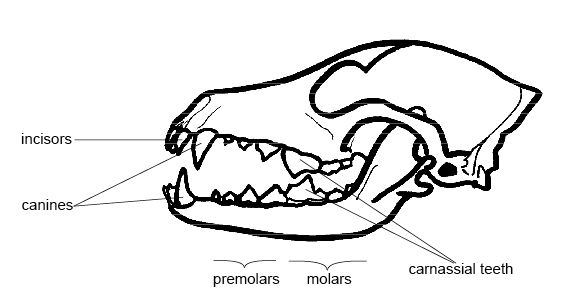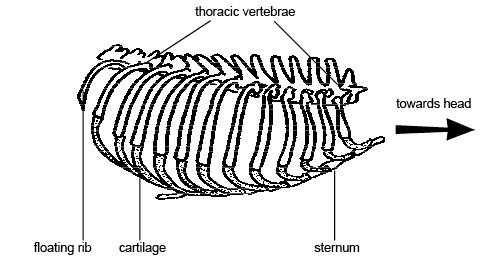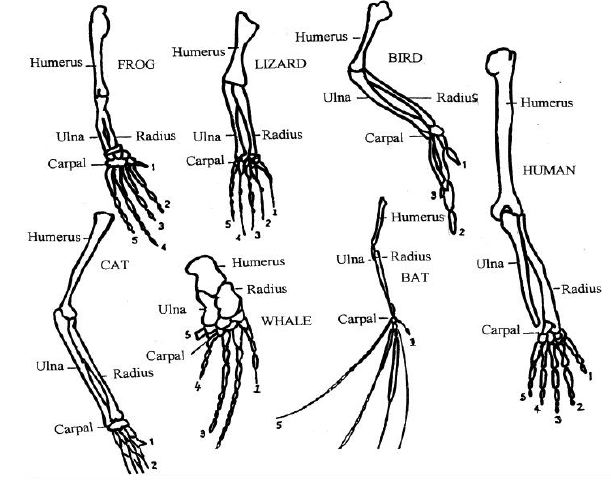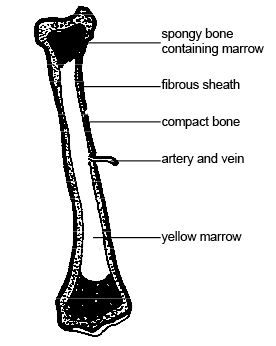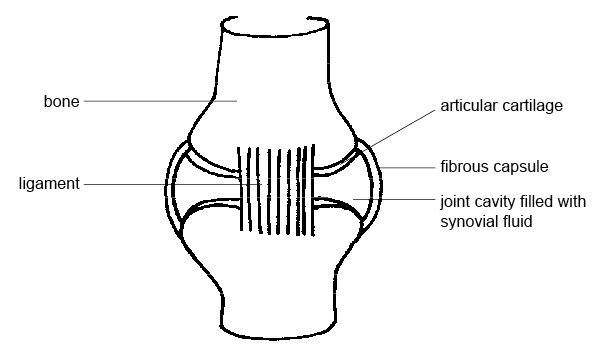Anatomy and Physiology of Animals/The Skeleton

Objectives
[edit | edit source]After completing this section, you should know:
- the functions of the skeleton
- the basic structure of a vertebrae and the regions of the vertebral column
- the general structure of the skull
- the difference between ‘true ribs’ and ‘floating ribs
- the main bones of the fore and hind limbs, and their girdles and be able to identify them in a live cat, dog, or rabbit
Fish, frogs, reptiles, birds and mammals are called vertebrates, a name that comes from the bony column of vertebrae (the spine) that supports the body and head. The rest of the skeleton of all these animals (except the fish) also has the same basic design with a skull that houses and protects the brain and sense organs and ribs that protect the heart and lungs and, in mammals, make breathing possible. Each of the four limbs is made to the same basic pattern. It is joined to the spine by means of a flat, broad bone called a girdle and consists of one long upper bone, two long lower bones, several smaller bones in the wrist or ankle and five digits (see diagrams 6.1 18,19 and 20).
Diagram 6.1 - The mammalian skeleton
The Vertebral Column
[edit | edit source]The vertebral column consists of a series of bones called vertebrae linked together to form a flexible column with the skull at one end and the tail at the other. Each vertebra consists of a ring of bone with spines (spinous process) protruding dorsally from it. The spinal cord passes through the hole in the middle and muscles attach to the spines making movement of the body possible (see diagram 6.2).
Diagram 6.2 - Cross section of a lumbar vertebrae
The shape and size of the vertebrae of mammals vary from the neck to the tail. In the neck there are cervical vertebrae with the two top ones, the atlas and axis, being specialized to support the head and allow it to nod “Yes” and shake “No”. Thoracic vertebrae in the chest region have special surfaces against which the ribs move during breathing. Grazing animals like cows and giraffes that have to support weighty heads on long necks have extra large spines on their cervical and thoracic vertebrae for muscles to attach to. Lumbar vertebrae in the loin region are usually large strong vertebrae with prominent spines for the attachment of the large muscles of the lower back. The sacral vertebrae are usually fused into one solid bone called the sacrum that sits within the pelvic girdle. Finally there are a variable number of small bones in the tail called the coccygeal vertebrae (see diagram 6.3).
Diagram 6.3 - The regions of the vertebral column dik
The Skull
[edit | edit source]The skull of mammals consists of 30 separate bones that grow together during development to form a solid case protecting the brain and sense organs. The “box “enclosing and protecting the brain is called the cranium (see diagram 6.4). The bony wall of the cranium encloses the middle and inner ears, protects the organs of smell in the nasal cavity and the eyes in sockets known as orbits. The teeth are inserted into the upper and lower jaws (see Chapter 5 for more on teeth) The lower jaw is known as the mandible. It forms a joint with the skull moved by strong muscles that allow an animal to chew. At the front of the skull is the nasal cavity, separated from the mouth by a plate of bone called the palate. Behind the nasal cavity and connecting with it are the sinuses. These are air spaces in the bones of the skull which help keep the skull as light as possible. At the base of the cranium is the foramen magnum, translated as “big hole”, through which the spinal cord passes. On either side of this are two small, smooth rounded knobs or condyles that articulate (move against) the first or Atlas vertebra.
Diagram 6.4 - A dog’s skull
The Rib
[edit | edit source]Paired ribs are attached to each thoracic vertebra against which they move in breathing. Each rib is attached ventrally either to the sternum or to the rib in front by cartilage to form the rib cage that protects the heart and lungs. In dogs one pair of ribs is not attached ventrally at all. They are called floating ribs (see diagram 6.5). Birds have a large expanded sternum called the keel to which the flight muscles (the ‘breast” meat of a roast chicken) are attached.
Diagram 6.5 - The rib
The Forelimb
[edit | edit source]The forelimb consists of: Humerus, radius and ulna, carpals, metacarpals, digits or phalanges (see diagram 6.6). The top of the humerus moves against (articulates with) the scapula at the shoulder joint. By changing the number, size and shape of the various bones, fore limbs have evolved to fit different ways of life. They have become wings for flying in birds and bats, flippers for swimming in whales, seals and porpoises, fast and efficient limbs for running in horses and arms and hands for holding and manipulating in primates (see diagram 6.8).
Diagram 6.6 - Forelimb of a dog
Diagram 6.7. Hindlimb of a dog
Diagram 6.8 - Various vertebrate limbs
Diagram 6.9 - Forelimb of a horse
In the horse and other equines, the third toe is the only toe remaining on the front and real limbs. Each toe is made up of a proximal phalange, a middle phalange, and distal phalange (and some small bones often referred to as sesamoids. In this image, the proximal phalange is labeled P3 and the distal phalange is labeled hoof. (which is more properly the name of the keratin covering that we see in the living animal).
The legs of the horse are highly adapted to give it great galloping speed over long distances. The bones of the lower leg and foot are greatly elongated and the hooves are actually the tips of the third fingers and toes, the other digits having been lost or reduced (see diagram 6.9).
The Hind Limb
[edit | edit source]The hind limbs have a similar basic pattern to the forelimb. They consist of: femur, tibia and fibula, tarsals, metatarsals, digits or phalanges (see diagram 6.7). The top of the femur moves against (articulates with) the pelvis at the hip joint.
The Girdles
[edit | edit source]The girdles pass on the “push” produced by the limbs to the body. The shoulder girdle or scapula is a triangle of bone surrounded by the muscles of the back but not connected directly to the spine (see diagram 6.1). This arrangement helps it to cushion the body when landing after a leap and gives the forelimbs the flexibility to manipulate food or strike at prey. Animals that use their forelimbs for grasping, burrowing or climbing have a well-developed clavicle or collar bone. This connects the shoulder girdle to the sternum. Animals like sheep, horses and cows that use their forelimbs only for supporting the body and locomotion have no clavicle. The pelvic girdle or hipbone attaches the sacrum and the hind legs. It transmits the force of the leg-thrust in walking or jumping directly to the spine (see diagram 6.10).
Diagram 6.10 - The pelvic girdle
Categories Of Bones
[edit | edit source]People who study skeletons place the different bones of the skeleton into groups according to their shape or the way in which they develop. Thus we have long bones like the femur, radius and finger bones, short bones like the ones of the wrist and ankle, irregular bones like the vertebrae and flat bones like the shoulder blade and bones of the skull. Finally there are bones that develop in tissue separated from the main skeleton. These include sesamoid bones which include bones like the patella or kneecap that develop in tendons and visceral bones that develop in the soft tissue of the penis of the dog and the cow’s heart.
Bird anatomy by Dr.Ankit Kumar Birman
Bird Skeletons
[edit | edit source]Although the skeleton of birds is made up of the same bones as that of mammals, many are highly adapted for flight. The most noticeable difference is that the bones of the forelimbs are elongated to act as wings. The large flight muscles make up as much as 1/5th of the body weight and are attached to an extension of the sternum called the keel. The vertebrae of the lower back are fused to provide the rigidity needed to produce flying movements. There are also many adaptations to reduce the weight of the skeleton. For instance birds have a beak rather than teeth and many of the bones are hollow (see diagram 6.11).
Diagram 6.11 - A bird’s skeleton
The Structure Of Long Bones
[edit | edit source]A long bone consists of a central portion or shaft and two ends called epiphyses (see diagram 6.12). Long bones move against or articulate with other bones at joints and their ends have flattened surfaces and rounded protuberances (condyles) to make this possible. If you carefully examine a long bone you may also see raised or rough surfaces. This is where the muscles that move the bones are attached. You will also see holes (a hole is called a foramen) in the bone. Blood vessels and nerves pass into the bone through these. You may also be able to see a fine line at each end of the bone. This is called the growth plate or epiphyseal line and marks the place where increase in length of the bone occurred (see diagram 6.16).
Diagram 6.12 - A femur
6.13 - A longitudinal section through a long bone
If you cut a long bone lengthways you will see it consists of a hollow cylinder (see diagram 6.13). The outer shell is covered by a tough fibrous sheath to which the tendons are attached. Under this is a layer of hard, dense compact bone (see below). This gives the bone its strength. The central cavity contains fatty yellow marrow, an important energy store for the body, and the ends are made from honeycomb-like bony material called spongy bone (see box below). Spongy bone contains red marrow where red blood cells are made.
Compact Bone
[edit | edit source]Compact bone is not the lifeless material it may appear at first glance. It is a living dynamic tissue with blood vessels, nerves and living cells that continually rebuild and reshape the bone structure as a result of the stresses, bends and breaks it experiences. Compact bone is composed of microscopic hollow cylinders that run parallel to each other along the length of the bone. Each of these cylinders is called a Haversian system. Blood vessels and nerves run along the central canal of each Haversian system. Each system consists of concentric rings of bone material (the matrix) with minute spaces in it that hold the bone cells. The hard matrix contains crystals of calcium phosphate, calcium carbonate and magnesium salts with collagen fibres that make the bone stronger and somewhat flexible. Tiny canals connect the cells with each other and their blood supply (see diagram 6.14).
Diagram 6.14 - Haversian systems of compact bone
Spongy Bone
[edit | edit source]Spongy bone gives bones lightness with strength. It consists of an irregular lattice that looks just like an old fashioned loofah sponge (see diagram 6.15). It is found on the ends of long bones and makes up most of the bone tissue of the limb girdles, ribs, sternum, vertebrae and skull. The spaces contain red marrow, which is where red blood cells are made and stored.
Diagram 6.15 - Spongy bone
Bone Growth
[edit | edit source]The skeleton starts off in the foetus as either cartilage or fibrous connective tissue. Before birth and, sometimes for years after it, the cartilage is gradually replaced by bone. The long bones increase in length at the ends at an area known as the epiphyseal plate where new cartilage is laid down and then gradually converted to bone. When an animal is mature, bone growth ceases and the epiphyseal plate converts into a fine epiphyseal line
Diagram 6.16 - A growing bone
Broken Bones
[edit | edit source]A fracture or break dramatically demonstrates the dynamic nature of bone. Soon after the break occurs blood pours into the site and cartilage is deposited. This starts to connect the broken ends together. Later spongy bone replaces the cartilage, which is itself replaced by compact bone. Partial healing to the point where some weight can be put on the bone can take place in 6 weeks but complete healing may take 3–4 months.
Joints
[edit | edit source]Joints are the structures in the skeleton where 2 or more bones meet. There are several different types of joints. Some are immovable once the animal has reached maturity. Examples of these are those between the bones of the skull and the midline joint of the pelvic girdle. Some are slightly moveable like the joints between the vertebrae but most joints allow free movement and have a typical structure with a fluid filled cavity separating the articulating surfaces (surfaces that move against each other) of the two bones. This kind of joint is called a synovial joint (see diagram 6.17). The joint is held together by bundles of white fibrous tissue called ligaments and a fibrous capsule encloses the joint. The inner layers of this capsule secrete the synovial fluid that acts as a lubricant. The articulating surfaces of the bones are covered with cartilage that also reduces friction and some joints, e.g. the knee, have a pad of cartilage between the surfaces that articulate with each other.
The shape of the articulating bones in a joint and the arrangement of ligaments determine the kind of movement made by the joint. Some joints only allow a to and from ‘gliding movement' e.g. between the ankle and wrist bones; the joints at the elbow, knee and fingers are hinge joints and allow movement in two dimensions and the axis vertebra pivots on the atlas vertebra. Ball and socket joints, like those at the shoulder and hip, allow the greatest range of movement.
Diagram 6.17 - A synovial joint
Common Names Of Joints
[edit | edit source]Some joints in animals are given common names that tend to be confusing. For example:
- The joint between the femur and the tibia on the hind leg is our knee but the stifle in animals.
- Our ankle joint (between the tarsals and metatarsals) is the hock in animals
- Our knuckle joint (between the metacarpals or metatarsals and the phalanges) is the fetlock in the horse.
- The “knee” on the horse is equivalent to our wrist (ie on the front limb between the radius and metacarpals) see diagrams 6.6, 6.7, 6.8, 6.17 and 6.18.
Diagram 6.18 - The names of common joints of a horse
Diagarm 6.19 - The names of common joints of a dog
Locomotion
[edit | edit source]Different animals place different parts of the foot or forelimb on the ground when walking or running.
Humans and bears put the whole surface of the foot on the ground when they walk. This is known as plantigrade locomotion. Dogs and cats walk on their toes (digitigrade locomotion) while horses and pigs walk on their “toenails” or hoofs. This is called unguligrade locomotion (see diagram 6.20).
- Plantigrade locomotion (on the “palms of the hand) as in humans and bears
- Digitigrade locomotion (on the “fingers”) as in cats and dogs
- Unguligrade locomotion (on the “fingernails”) as in horses
Diagram 6.20 - Locomotion
Summary
[edit | edit source]- The skeleton maintains the shape of the body, protects internal organs and makes locomotion possible.
- The vertebrae support the body and protect the spinal cord. They consist of: cervical vertebrae in the neck, thoracic vertebrae in the chest region which articulate with the ribs, lumbar vertebrae in the loin region, sacral vertebrae fused to the pelvis to form the sacrum and tail or coccygeal vertebrae.
- The skull protects the brain and sense organs. The cranium forms a solid box enclosing the brain. The mandible forms the jaw.
- The forelimb consists of the humerus, radius, ulna, carpals, metacarpals and phalanges. It moves against or articulates with the scapula at the shoulder joint.
- The hindlimb consists of the femur, patella, tibia, fibula, tarsals, metatarsals and digits. It moves against or articulates with the pelvis at the hip joint.
- Bones articulate against each other at joints.
- Compact bone in the shaft of long bones gives them their strength. Spongy bone at the ends reduces weight. Bone growth occurs at the growth plate.
Worksheet
[edit | edit source]Use the Skeleton Worksheet to learn the main parts of the skeleton.
Test Yourself
[edit | edit source]1. Name the bones which move against (articulate with)...
- a) the humerus
- b) the thoracic vertebrae
- c) the pelvis
2. Name the bones in the forelimb
3. Where is the patella found?
4. Where are the following joints located?
- a) The stifle joint:
- b) The hock joint
- c) The hip joint:
5. Attach the following labels to the diagram of the long bone shown below.
- a) compact bone
- b) spongy bone
- c) growth plate
- d) fibrous sheath
- e) red marrow
- f) blood vessel
6. Attach the following labels to the diagram of a joint shown below
- a) bone
- b) articular cartilage
- c) joint cavity
- d) capsule
- e) ligament
- f) synovial fluid.
Websites
[edit | edit source]- http://www.infovisual.info/02/056_en.html Bird skeleton
A good diagram of the bird skeleton.
A great introduction to the mammalian skeleton. A little above the level required but it has so much interesting information it's worth reading it.
- http://www.klbschool.org.uk/interactive/science/skeleton.htm The human skeleton
Test yourself on the names of the bones of the (human) skeleton.
Quite a good article on the different kinds of joints with diagrams.
- http://en.wikipedia.org/wiki/Bone Wikipedia
Wikipedia is disappointing where the skeleton is concerned. Most articles stick entirely to the human skeleton or have far too much detail. However this one on compact and spongy bone and the growth of bone is quite good although still much above the level required.



